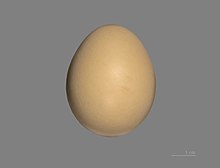Edwards's pheasant
| Edwards's pheasant | |
|---|---|

| |
| Male | |

| |
| Female, Zoo Bojnice, Slovakia | |
| Scientific classification | |
| Domain: | Eukaryota |
| Kingdom: | Animalia |
| Phylum: | Chordata |
| Class: | Aves |
| Order: | Galliformes |
| Family: | Phasianidae |
| Genus: | Lophura |
| Species: | L. edwardsi
|
| Binomial name | |
| Lophura edwardsi (Oustalet, 1896)
| |

Edwards's pheasant (Lophura edwardsi) is a bird of the pheasant family Phasianidae and is endemic to the rainforests of Vietnam. It is named after the French ornithologist Alphonse Milne-Edwards and first described to science in 1896[2] The bird's length is 58–65 centimetres (23–26 in) [3] and has red legs and facial skin. The male is mainly blue-black with a crest, and the female is a drab brown bird. The alarm call is a puk!-puk!-puk!.
There are two varieties; the nominate form L. e. edwardsi has a white crest and upper tail, whereas the northern form, usually called Vietnamese pheasant, is found with a variable number of white retrices. This difference in the two forms may be due to inbreeding of a restricted, fragmented population there, and has also been seen in captive, inbred L. edwardsi.
In 2012 the nominate form of Edwards's pheasant have been uplisted to Critically Endangered by BirdLife International, having suffered from deforestation, hunting and the use of defoliants during the Vietnam War. The population is currently believed to number between 50 and 249 birds in the wild, mostly of the nominate form, but it is doing well in captivity, where it is the subject of ex-situ conservation. There have been no confirmed sightings since 2000 and in 2010 the World Pheasant Association (WPA) received funding from the Critical Ecosystem Partnership Fund to survey forests in the central Vietnam provinces of Quảng Bình and Quảng Trị.[4]
References
- Pheasants, Partridges and Grouse by Madge and McGowan, ISBN 0-7136-3966-0
- ^ BirdLife International (2016). "Lophura edwardsi". The IUCN Red List of Threatened Species. 2016. IUCN: e.T45354985A95145107. doi:10.2305/IUCN.UK.2016-3.RLTS.T45354985A95145107.en. Retrieved 14 January 2018.
- ^ Beolens, Bo; Michael Watkins (2004). Whose Bird?: Common Bird Names and the People They Commemorate. Whose Bird?: Common Bird Names and the People They Commemorate. p. 116. ISBN 978-0-300-10359-5.
- ^ Birdlife International
- ^ Grainger, Matthew. "One of our pheasant's is missing". Birdguides. Retrieved 1 November 2011.
External links

